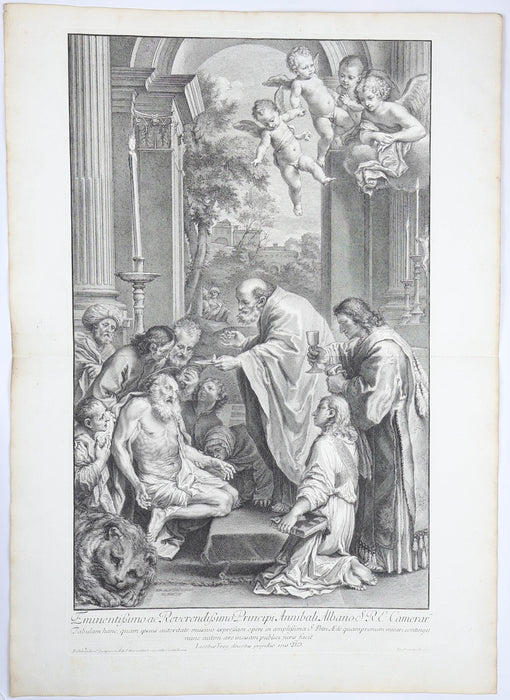
AFTER DOMENICHINO
[Frey, Jakob I]: [The holy communion of St Jerome; the latter, surrounded by onlookers who are supporting him, is kneeling to left of an altar; priest with host in the centre; angels hovering above; after Domenichino] (as described in British Museum catalogue). [Rome] Iac. Frey inc. An. 1729.
An impressive and large work by a master printmaker, made after the celebrated painting ‘The Holy Communion of St. Jerome’ (1614) by Domenico Zampieri or Domenichino (1581-1641). Depicting the last communion of St. Jerome, the original canvas, now in the Vatican Museum, was a ‘cause célèbre’ because Domenichino was publicly accused, some ten years after he made the work, of stealing his idea for the painting from the artist Agostino Carracci (1557-1602). This accusation had the effect of elevating the painting as an object of interest in 17th-cent. art-historical writing, with scholars discussing the nature of stealing and imitation in art, and coming out in defence of the artist. The interest led in turn to a series of print reproductions of which this may have been the largest to date (three preceded it; we have been able to check the dimensions of two). In our present dedication, Frey celebrates that a mosaic of the image was made for St. Peter’s (as happened). His dedicatee is the prelate in charge of those works, Cardinal Annibale Albani (1682-1751).
Jakob I Frey (1681-1752) “was the son of the sculptor in wood Hans Heinrich Frey (fl 1650–80). With support from Franz Josef Meyer von Schauensee he went to Rome in 1702. For several months he was a pupil of the Flemish engraver Arnold van Westerhout, and then the painter Carlo Maratti. Maratti’s influence was decisive, as he drew Frey’s attention to the picturesque qualities of etching. Thereafter Frey combined etching and engraving in most of his prints. His very precise and accurate reproductive engravings after 17th- and 18th-century Old Masters, for example the Aurora (1722) after Guido Reni and the Flight into Egypt (1735) after Maratti, are his most important works. The most complete collection of his graphic works is in the Zentralbibliothek in Lucerne. In 1726 he returned briefly to Switzerland; he was also commissioned to design the ceiling fresco for the nave of St Jost Church at Blatten, Lucerne” (Jeanne-Marie Horat-Weber, ‘Frey, Johann Jakob, I (the Elder)’ in Grove Art Online).
Details
First edition thus. Etched and engraved print on a large sheet, 52.6 cms. x 73.2 cms. (the print, 39.9 cms. x 67 cms. within platemarks). Slight soiling to margins (outside plate-marks), otherwise very good. An old hinge to verso indicates it had been preserved in an album.
Bätschmann, 204-5 (no. 147). See Elizabeth Cropper, The Domenichino Affair (New Haven/London 2005), 10-11 and n. 39.
